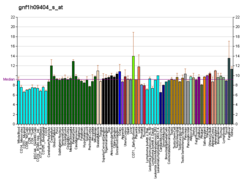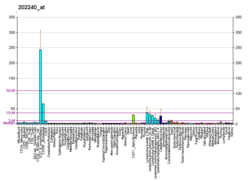PLK1
PLK1(polo-like kinase 1)またはSTPK13(serine/threonine protein kinase 13)は、ヒトではPLK1遺伝子によってコードされる酵素(プロテインキナーゼ)である[5]。
構造
編集PLK1は603アミノ酸から構成され、66 kDaである。N末端のキナーゼドメインに加えて、C末端には約30アミノ酸からなる保存されたpolo-box領域が2つ存在している。キナーゼ活性は少なくとも部分的にはpolo-boxによって調節されており、polo-boxは自己阻害と細胞内局在の両面で機能的に重要である[6]。
局在
編集間期の間、PLK1は中心体に局在する。有糸分裂の初期には、紡錘体極に結合している。組換えGFP-PLK1融合タンパク質はセントロメア/キネトコア領域に局在することから、染色体分離に関与している可能性が示唆されている[7]。
細胞周期の調節
編集PLK1はG2/M期の移行の初期のトリガーとなる。PLK1は、G2期終盤から有糸分裂前期の序盤にかけての中心体の機能的成熟と、双極性の紡錘体構造の確立を支える。PLK1はサイクリンB/CDK1複合体を脱リン酸化し活性化するホスファターゼである、CDC25Cをリン酸化して活性化する。Poloキナーゼは後期促進複合体(APC)の構成要素もリン酸化し活性化する。Fizzy/Cdc20ファミリーのタンパク質によって活性化されるAPCは、M期サイクリン、姉妹染色分体間の接着を維持する染色体タンパク質、後期の阻害因子を分解する細胞周期関連ユビキチンリガーゼ(E3)である。また、Poloキナーゼの基質であるAsp(ヒトではASPM)は、紡錘体極やM期微小管の正確な挙動に必要不可欠な微小管結合タンパク質である。有糸分裂の終盤にはPLK1は紡錘体の中心領域に局在し、キネシン様タンパク質CHO1/MKLP1と結合する。このモータータンパク質はショウジョウバエのPavarotti(PAR)と相同である[8]。
酵母やマウスにおける減数分裂の研究に基づくと、ヒトのPLK1も減数分裂の調節機能を持つ可能性がある。出芽酵母Saccharomyces cerevisiaeのPoloキナーゼであるCDC5は、減数第一分裂時のコヒーシンのリン酸化と除去に必要である。CDC5が枯渇した細胞では、キネトコアは第一分裂の際も紡錘体と二方向型の(bi-oriented)結合を行い、共方向型(co-oriented)の結合に必要不可欠なタンパク質であるMam1はキネトコアに結合できない。CDC5は減数第一分裂時の姉妹キネトコアの共方向性と染色体分離に関与していると考えられている[9]。
腫瘍形成における役割
編集PLK1は幅広い種類のがんで過剰発現しており、その発現は予後の悪さと相関していることが多い[10]。PLK1はがん抑制因子p53関連経路に関与しているようである。PLK1はp53との物理的な相互作用とリン酸化によって、トランス活性化能とアポトーシス促進機能を阻害することを示唆する証拠が得られている[11]。
臨床的意義
編集培養細胞でのRNAiによるPLK1の発現のサイレンシングは、KRASに発がん性変異を持つ細胞の選択的な死滅をもたらすが、正常細胞には無害である[12][13]。
PLK1阻害剤ボラセルチブは、急性骨髄性白血病(AML)に対する臨床試験による評価が行われている[14]。PLK1阻害とEGFR阻害の併用は、非小細胞肺癌(NSCLC)のEGFR T790M変異による薬剤耐性をin vitroとin vivoで克服する[15]。 頭頸部扁平上皮癌では、AJUBAの変異はPLK1阻害剤ボラセルチブを含む細胞周期阻害薬治療に対する感受性を媒介する[16]。間葉系NSCLC細胞では、PLK1がビメンチンのリン酸化を調節し、β1-インテグリンを介してc-Metの活性化をもたらす。c-Met阻害とPLK1阻害の併用は、NSCLCのin vivoモデルで有意な腫瘍縮小をもたらした[17]。
相互作用
編集PLK1は次に挙げる因子と相互作用することが示されている。
PLK1の幅広い基質特異性を説明するために構造解析が行われている[28]。
出典
編集- ^ a b c GRCh38: Ensembl release 89: ENSG00000166851 - Ensembl, May 2017
- ^ a b c GRCm38: Ensembl release 89: ENSMUSG00000030867 - Ensembl, May 2017
- ^ Human PubMed Reference:
- ^ Mouse PubMed Reference:
- ^ “Induction and down-regulation of PLK, a human serine/threonine kinase expressed in proliferating cells and tumors”. Proceedings of the National Academy of Sciences of the United States of America 91 (5): 1736–40. (March 1994). Bibcode: 1994PNAS...91.1736H. doi:10.1073/pnas.91.5.1736. PMC 43238. PMID 8127874.
- ^ “The crystal structure of the human polo-like kinase-1 polo box domain and its phospho-peptide complex”. The EMBO Journal 22 (21): 5757–68. (November 2003). doi:10.1093/emboj/cdg558. PMC 275415. PMID 14592974.
- ^ “Self-regulated mechanism of Plk1 localization to kinetochores: lessons from the Plk1-PBIP1 interaction”. Cell Division 3: 4. (January 2008). doi:10.1186/1747-1028-3-4. PMC 2263035. PMID 18215321.
- ^ “Polo-like kinases: a team in control of the division”. Cell Cycle 5 (8): 853–64. (April 2006). doi:10.4161/cc.5.8.2692. PMID 16627997.
- ^ Lee, Brian H.; Amon, Angelika (2003-04-18). “Role of Polo-like kinase CDC5 in programming meiosis I chromosome segregation”. Science (New York, N.Y.) 300 (5618): 482–486. doi:10.1126/science.1081846. ISSN 1095-9203. PMID 12663816.
- ^ “Cell cycle kinases in cancer”. Current Opinion in Genetics & Development 17 (1): 60–5. (February 2007). doi:10.1016/j.gde.2006.12.008. PMID 17208431.
- ^ “Polo-like kinase (Plk)1 depletion induces apoptosis in cancer cells”. Proceedings of the National Academy of Sciences of the United States of America 100 (10): 5789–94. (May 2003). Bibcode: 2003PNAS..100.5789L. doi:10.1073/pnas.1031523100. PMC 156279. PMID 12732729.
- ^ Downward, Julian (2009-08-27). “Finding the weakness in cancer”. The New England Journal of Medicine 361 (9): 922–924. doi:10.1056/NEJMcibr0905242. ISSN 1533-4406. PMID 19710492.
- ^ “A genome-wide RNAi screen identifies multiple synthetic lethal interactions with the Ras oncogene”. Cell 137 (5): 835–48. (May 2009). doi:10.1016/j.cell.2009.05.006. PMC 2768667. PMID 19490893.
- ^ “Spotlight on Volasertib: Preclinical and Clinical Evaluation of a Promising Plk1 Inhibitor”. Medicinal Research Reviews 36 (4): 749–86. (July 2016). doi:10.1002/med.21392. PMID 27140825.
- ^ “Polo-like kinase 1 inhibition diminishes acquired resistance to epidermal growth factor receptor inhibition in non-small cell lung cancer with T790M mutations”. Oncotarget 7 (30): 47998–48010. (July 2016). doi:10.18632/oncotarget.10332. PMC 5216995. PMID 27384992.
- ^ “Mutations of the LIM protein AJUBA mediate sensitivity of head and neck squamous cell carcinoma to treatment with cell-cycle inhibitors”. Cancer Letters 392: 71–82. (April 2017). doi:10.1016/j.canlet.2017.01.024. PMC 5404895. PMID 28126323.
- ^ a b “Non-canonical cMet regulation by vimentin mediates Plk1 inhibitor-induced apoptosis”. EMBO Molecular Medicine 11 (5). (May 2019). doi:10.15252/emmm.201809960. PMC 6505578. PMID 31040125.
- ^ “Preclinical pharmacokinetic and pharmacodynamic evaluation of novel anticancer agents, ON01910.Na (Rigosertib, Estybon™) and ON013105, for brain tumor chemotherapy”. Pharmaceutical Research 29 (9): 2499–511. (September 2012). doi:10.1007/s11095-012-0780-y. PMID 22678771.
- ^ “Polo-like kinase 1 and Chk2 interact and co-localize to centrosomes and the midbody”. The Journal of Biological Chemistry 278 (10): 8468–75. (March 2003). doi:10.1074/jbc.M211202200. PMID 12493754.
- ^ “A role for Plk1 phosphorylation of NudC in cytokinesis”. Developmental Cell 5 (1): 127–38. (July 2003). doi:10.1016/s1534-5807(03)00186-2. PMID 12852857.
- ^ “The essential mitotic peptidyl-prolyl isomerase Pin1 binds and regulates mitosis-specific phosphoproteins”. Genes & Development 12 (5): 706–20. (March 1998). doi:10.1101/gad.12.5.706. PMC 316589. PMID 9499405.
- ^ “Function of WW domains as phosphoserine- or phosphothreonine-binding modules”. Science 283 (5406): 1325–8. (February 1999). Bibcode: 1999Sci...283.1325L. doi:10.1126/science.283.5406.1325. PMID 10037602.
- ^ “Phosphorylation of BRCA2 by the Polo-like kinase Plk1 is regulated by DNA damage and mitotic progression”. Oncogene 23 (4): 865–72. (January 2004). doi:10.1038/sj.onc.1207223. PMID 14647413.
- ^ “M phase-specific phosphorylation of BRCA2 by Polo-like kinase 1 correlates with the dissociation of the BRCA2-P/CAF complex”. The Journal of Biological Chemistry 278 (38): 35979–87. (September 2003). doi:10.1074/jbc.M210659200. PMID 12815053.
- ^ a b c d “Polo-like kinase interacts with proteasomes and regulates their activity”. Cell Growth & Differentiation 12 (1): 29–37. (January 2001). PMID 11205743.
- ^ “Hamartin, the tuberous sclerosis complex 1 gene product, interacts with polo-like kinase 1 in a phosphorylation-dependent manner”. Human Molecular Genetics 15 (2): 287–97. (January 2006). doi:10.1093/hmg/ddi444. PMID 16339216.
- ^ “Polo-like Kinase 1 Regulates Vimentin Phosphorylation at Ser-56 and Contraction in Smooth Muscle”. The Journal of Biological Chemistry 291 (45): 23693–23703. (November 2016). doi:10.1074/jbc.M116.749341. PMC 5095422. PMID 27662907.
- ^ “Computational analysis of phosphopeptide binding to the polo-box domain of the mitotic kinase PLK1 using molecular dynamics simulation”. PLOS Computational Biology 6 (8): e1000880. (August 2010). Bibcode: 2010PLSCB...6E0880H. doi:10.1371/journal.pcbi.1000880. PMC 2920843. PMID 20711360.
関連項目
編集- ポロ様キナーゼ - PLK1が属するファミリー






